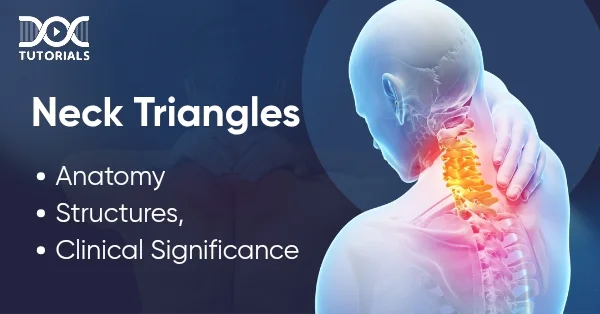Neck Triangles: Anatomy, Structures, and Clinical Significance

Understanding the anatomy of the neck triangles is essential for recognising the spatial organisation of important muscular, neurovascular, and lymphatic structures.
These cervical triangles are particularly significant in clinical assessments, surgical procedures, and radiological evaluations. This is an essential area of focus for aspiring medical students preparing for the NEET PG examination.
Each neck triangle contains distinct structures that are essential for the proper functioning of the head, neck, and upper limbs. A thorough understanding of their boundaries and contents is fundamental for both academic success and practical application in clinical settings.
Keep reading for a detailed insight into neck triangles.
What are the Different Triangles of the Neck?
The sternocleidomastoid muscle runs diagonally across the side of the neck, creating the boundary that separates the anterior triangle from the posterior triangle, which are discussed below in-depth:
- Anterior Triangle
The anterior triangles are paired anatomical regions located on the front of the neck, lying beneath the superficial cervical fascia and the platysma muscle. The anterior border of the sternocleidomastoid muscle forms the lateral boundary of each triangle.
The triangle’s upper boundary is formed by the lower margin of the mandible, and its medial border is outlined by the midline of the neck. These anterior neck triangles divide further into four smaller regions: the submandibular and submental triangles lie in the upper portion, whereas the muscular and carotid triangles occupy the lower part of this compartment.
- Submandibular Triangle
The digastric triangle, also known as the submandibular triangle, shares its upper boundary with the anterior triangle, marked by the lower edge of the mandible. Its lower boundaries are shaped by the anterior belly of the digastric muscle in front and the posterior belly of the digastric muscle, together with the stylohyoid muscle at the back.
The apex of this triangle is located at the intermediate tendon of the digastric muscle. The mylohyoid and hyoglossus muscles form the base of the triangle, whereas the covering layer comprises the fascia, skin, and platysma muscle.
Borders
- Superior: Inferior margin of the mandible
- Anterior: Anterior belly of the digastric muscle
- Posterior: Posterior belly of the digastric muscle
Contents
- Viscera: The submandibular gland and lymph nodes lie in the anterior portion, with the posterior section containing the lower part of the parotid gland
- Vessels: Submental artery and vein, facial artery and vein, and the lingual arteries and veins
- Nerves: Mylohyoid nerve and hypoglossal nerve (cranial nerve XII)
This triangle encloses essential structures such as salivary glands, vascular networks and cranial nerves, making it clinically significant for surgical access and diagnostic evaluation.
- Submental Triangle
Positioned between the anterior bellies of the right and left digastric muscles, the submental triangle has its base along the body of the hyoid bone, with its apex directed towards the symphysis menti. Similar to the submandibular triangle, its floor consists of the mylohyoid muscles, and its roof consists of skin, fascia, and platysma.
Borders
- Inferior: Hyoid bone
- Lateral: Anterior belly of the digastric muscle
- Medial: Midline of the neck
Contents
- Small tributaries draining into the anterior jugular vein
- Submental lymph nodes
This triangle contains venous branches contributing to the anterior jugular vein and houses the submental lymph nodes, which are clinically relevant in assessing infections or malignancies affecting the lower face and anterior oral cavity.
- Muscular Triangle
The muscular triangle, also called the orotracheal triangle, has its medial border aligned with the anterior triangle along the neck’s midline. It originates at the inferior margin of the hyoid bone.
This triangle has 2 posterior borders—the upper part of the anterior margin of the sternocleidomastoid muscle forms the lower boundary, while the front portion of the superior belly of the omohyoid muscle forms the upper boundary.
Borders
- Superior: Lower border of the hyoid bone
- Lateral: Superior belly of the omohyoid and anterior border of the sternocleidomastoid
- Medial: Midline of the neck
Contents
- Muscles: The infrahyoid group, comprising the sternohyoid, sternothyroid, and thyrohyoid muscles.
- Vessels: Includes the superior and inferior thyroid arteries along with the anterior jugular veins.
- Viscera: Larynx, oesophagus, trachea, thyroid and parathyroid glands
The muscular triangle tapers to a point where the sternocleidomastoid intersects with the omohyoid muscle. This area contains important infrahyoid muscles, crucial blood vessels, and vital cervical organs, all of which are essential for the neck’s function and hold significant clinical importance.
- Carotid Triangle
The carotid triangle is bounded by the sternocleidomastoid and omohyoid muscles. Here, the front boundary is formed by the rear edge of the superior belly of the omohyoid muscle, whereas the back boundary is defined by the front edge of the sternocleidomastoid muscle.
Borders
- Anterior: The back edge of the superior belly of the omohyoid muscle
- Superior: The stylohyoid muscle and the posterior belly of the digastric muscle
- Posterior: Anterior border of the sternocleidomastoid muscle
Contents
- Arteries: The common carotid artery, the internal carotid artery (which includes the carotid sinus), and various branches of the external carotid artery are present, except for the maxillary, superficial temporal, and posterior auricular arteries, which are not included.
- Veins: Common facial, lingual, middle thyroid veins, superior thyroid, and internal jugular vein
- Nerves: Vagus nerve (cranial nerve X), hypoglossal nerve (cranial nerve XII), and a portion of the sympathetic trunk
The upper limit of the triangle is formed by the posterior belly of the digastric muscle together with the stylohyoid muscle. The base consists of the middle and lower pharyngeal constrictor muscles, the hyoglossus, and sections of the thyrohyoid muscle.
The roof consists of the superficial and deep layers of cervical fascia, the platysma, and the skin above. This triangle is of high clinical importance as it houses several key arteries, veins, and nerves supplying the head and neck.
- Posterior Triangle
The posterior triangle is a distinct anatomical region located behind the sternocleidomastoid muscle. 3 key boundaries define it.
The front border is created by the posterior margin of the sternocleidomastoid muscle, whereas the rear border is defined by the anterior margin of the trapezius muscle. The inferior boundary is made up of the middle third of the clavicle.
- Occipital Triangle
The occipital triangle has the same anterior and posterior borders as the posterior triangle. However, its lower border differs. The superior edge of the inferior belly of the omohyoid muscle forms it.
Borders
- Anterior: Posterior edge of the sternocleidomastoid muscle
- Posterior: Anterior edge of the trapezius muscle
- Inferior: Superior margin of the inferior belly of the omohyoid muscle
Contents
- Accessory nerve (cranial nerve XI)
- Branches of the cervical plexus
- Uppermost portion of the brachial plexus
- Supraclavicular nerve
The floor of the occipital triangle consists, from top to bottom, of the semispinalis capitis (sometimes), splenius capitis, levator scapulae and the middle and posterior scalene muscles. Its roof is composed of the skin, superficial fascia and deep fascia in successive layers.
This triangle holds important neurovascular structures and serves as a key landmark in clinical and surgical procedures involving the posterior neck.
- Supraclavicular Triangle
Also called the greater supraclavicular fossa, it is the smaller division of the posterior triangle. It shares its anterior and inferior boundaries with the posterior triangle but differs superiorly, where it is bordered by the lower edge of the inferior belly of the omohyoid muscle.
Borders
- Superior: Inferior belly of the omohyoid muscle
- Anterior: Posterior border of the sternocleidomastoid muscle
- Inferior: Clavicle
Contents
- The third segment of the subclavian artery
- Trunks of the brachial plexus
- Nerve to the subclavius muscle
- Lymph nodes
The base of the triangle is composed of the scalenus medius muscle, the initial portion of the serratus anterior, and the first rib. The roof includes skin, superficial fascia and the platysma. Its anatomical importance makes it a key area for clinical examination and surgical access.
FAQs About Neck Triangles
- How many main neck triangles are there?
There are 2 main triangles on each side of the neck — the anterior and posterior triangles. Each of these neck triangles is further divided into smaller triangles.
- What structures are found in the carotid triangle?
The carotid triangle contains the common and internal carotid arteries, the vagus and hypoglossal nerves, the internal jugular vein, and parts of the sympathetic trunk.
- What is the anatomical location of the apex of the posterior triangle of the neck?
The tip of the posterior triangle is where the sternocleidomastoid and trapezius muscles meet near the superior nuchal line on the occipital bone. This spot represents the highest point of the triangle and serves as an essential anatomical reference during neck assessments.
- Which triangle contains the submandibular gland?
The submandibular gland is located in the anterior neck’s submandibular (digastric) triangle.
- What forms the boundaries of the muscular triangle?
The neck’s midline bounds it, the omohyoid’s superior belly, and the sternocleidomastoid’s anterior border.
Conclusion
A clear understanding of the neck triangles is vital for both anatomical study and clinical application. Each triangle of the neck contains critical structures that support essential functions of the head, neck, and upper limbs.
Neck triangles are a vital topic for NEET PG aspirants. By mastering their boundaries and contents, medical students can improve their diagnostic accuracy, enhance surgical precision, and interpret radiological findings more effectively.
Learn more about this topic with DocTutorials’ NEET PG study materials, top-grade video lectures, QRP (Quick Revision Programs), etc.
Want to secure top rank in NEET PG? Enrol in our NEET PG course today!
Latest Blogs
-

NEET PG Exam 2025- Date, Pattern, Marking Scheme, Subject Wise Weightage, and Exam Mode
NEET PG Exam 2025 is the ultimate gateway for medical graduates aspiring to pursue postgraduate courses in medicine, including MD,…
-

INI CET Exam 2025: Your Roadmap to Success – Key Topics, Strategies, and Lessons from Last Year’s Papers
The INI CET exam is more than just a test; it’s a significant milestone for many medical students aiming to…
-

INI CET Exam Success: Previous Year Question Papers & Ultimate Guide – INI CET PYQ
One can feel overwhelmed while preparing for the INI CET (Institute of National Importance Combined Entrance Test). A vast syllabus,…




